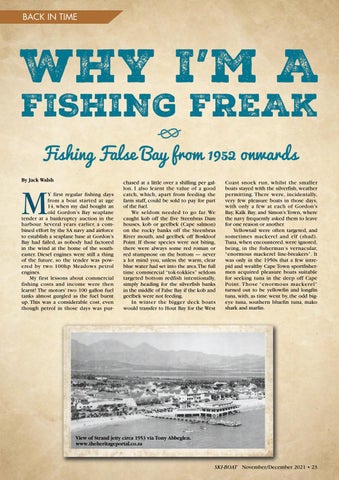BACK IN TIME
By Jack Walsh
M
Y first regular fishing days from a boat started at age 14, when my dad bought an old Gordon’s Bay seaplane tender at a bankruptcy auction in the harbour. Several years earlier, a combined effort by the SA navy and airforce to establish a seaplane base at Gordon’s Bay had failed, as nobody had factored in the wind at the home of the southeaster. Diesel engines were still a thing of the future, so the tender was powered by two 100hp Meadows petrol engines. My first lessons about commercial fishing costs and income were then learnt! The motors’ two 100 gallon fuel tanks almost gurgled as the fuel burnt up. This was a considerable cost, even though petrol in those days was pur-
chased at a little over a shilling per gallon. I also learnt the value of a good catch, which, apart from feeding the farm staff, could be sold to pay for part of the fuel. We seldom needed to go far. We caught kob off the five Steenbras Dam houses, kob or geelbek (Cape salmon) on the rocky banks off the Steenbras River mouth, and geelbek off Boskloof Point. If those species were not biting, there were always some red roman or red stumpnose on the bottom — never a lot mind you, unless the warm, clear blue water had set into the area.The full time commercial “tok-tokkies” seldom targeted bottom redfish intentionally, simply heading for the silverfish banks in the middle of False Bay if the kob and geelbek were not feeding. In winter the bigger deck boats would transfer to Hout Bay for the West
Coast snoek run, whilst the smaller boats stayed with the silverfish, weather permitting. There were, incidentally, very few pleasure boats in those days, with only a few at each of Gordon’s Bay, Kalk Bay, and Simon’s Town, where the navy frequently asked them to leave for one reason or another. Yellowtail were often targeted, and sometimes mackerel and elf (shad). Tuna, when encountered, were ignored, being, in the fisherman’s vernacular, “enormous mackerel line-breakers”. It was only in the 1950s that a few intrepid and wealthy Cape Town sportfishermen acquired pleasure boats suitable for seeking tuna in the deep off Cape Point. Those “enormous mackerel” turned out to be yellowfin and longfin tuna, with, as time went by, the odd bigeye tuna, southern bluefin tuna, mako shark and marlin.
View of Strand jetty circa 1953 via Tony Abbeglen. www.theheritageportal.co.za
SKI-BOAT November/December 2021 • 23








